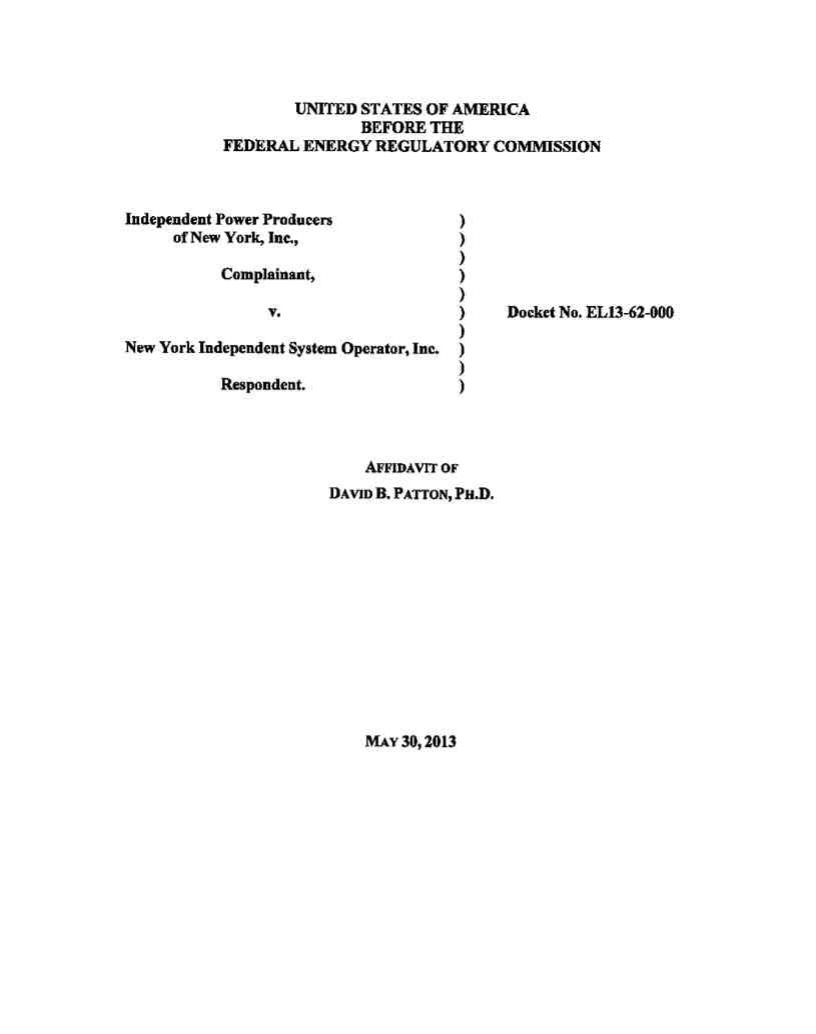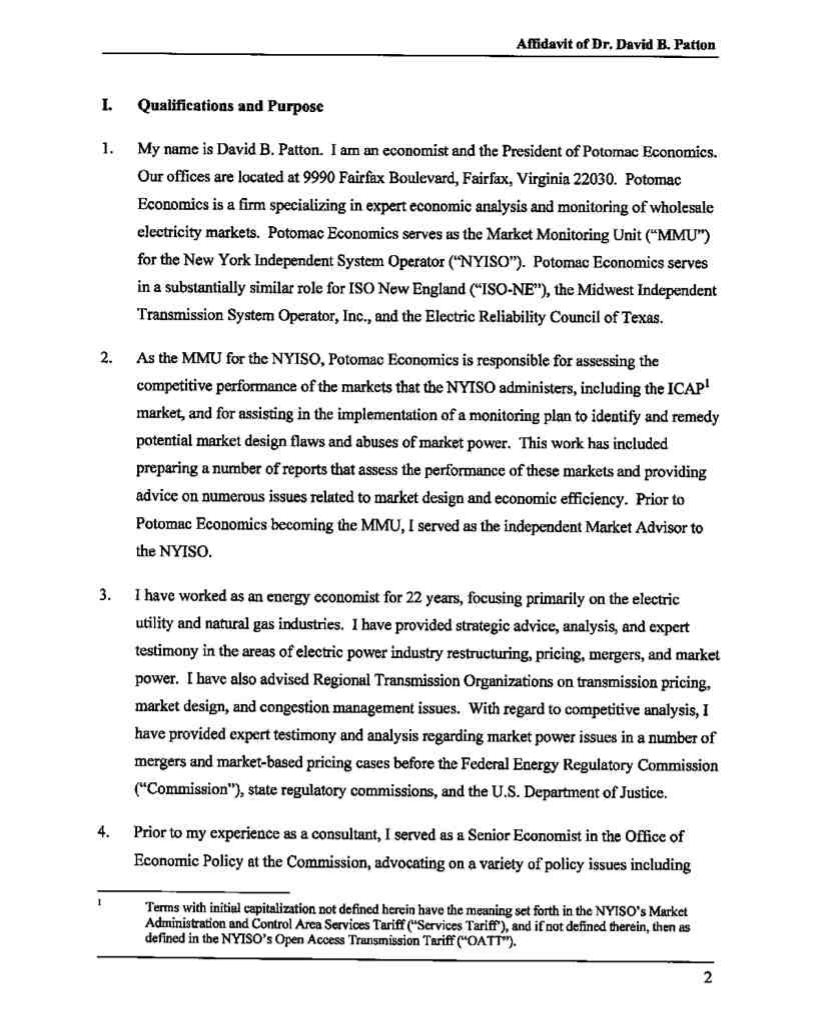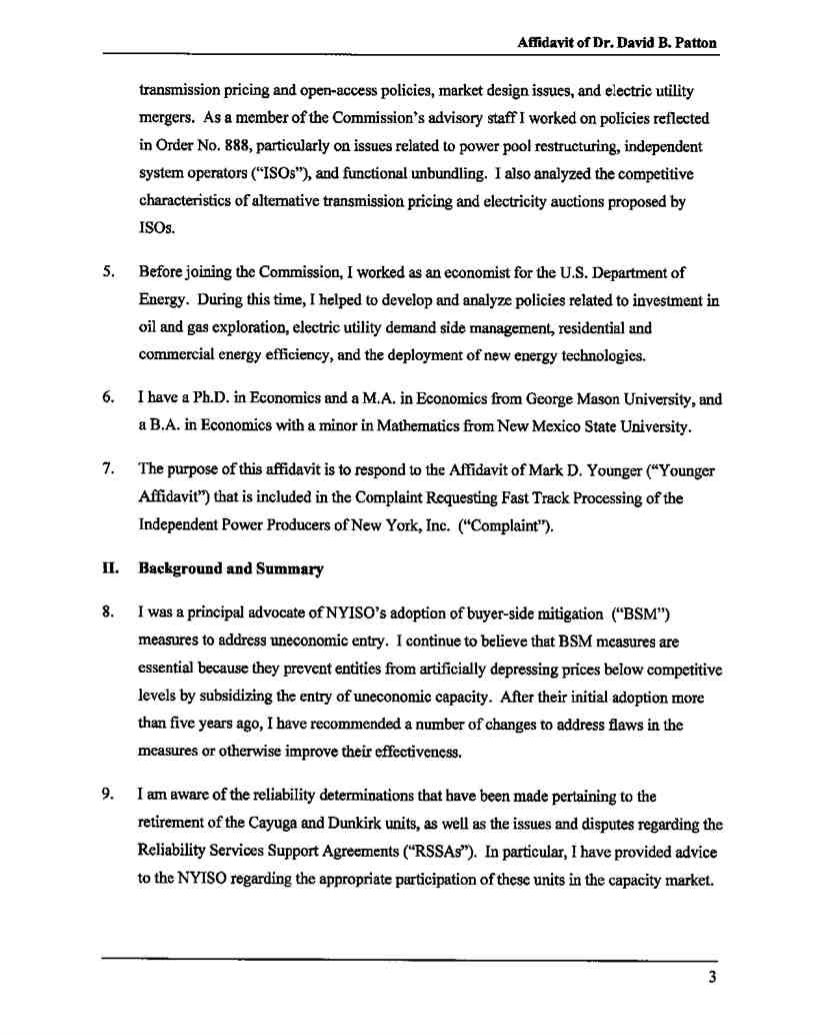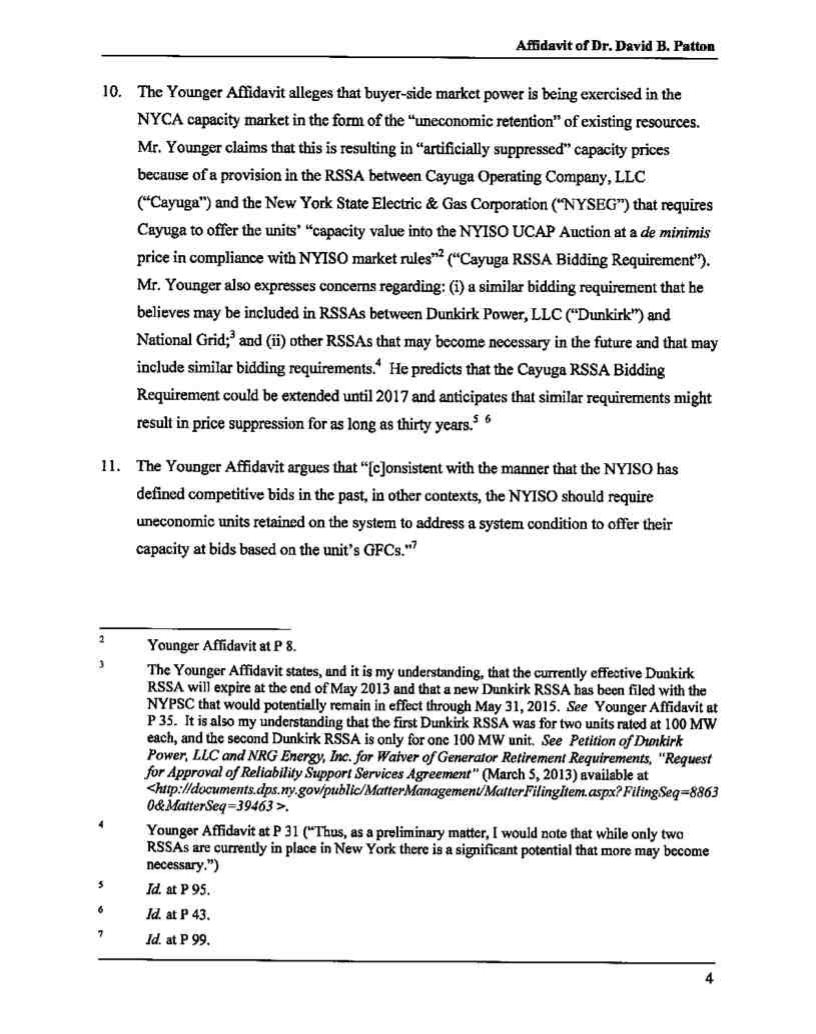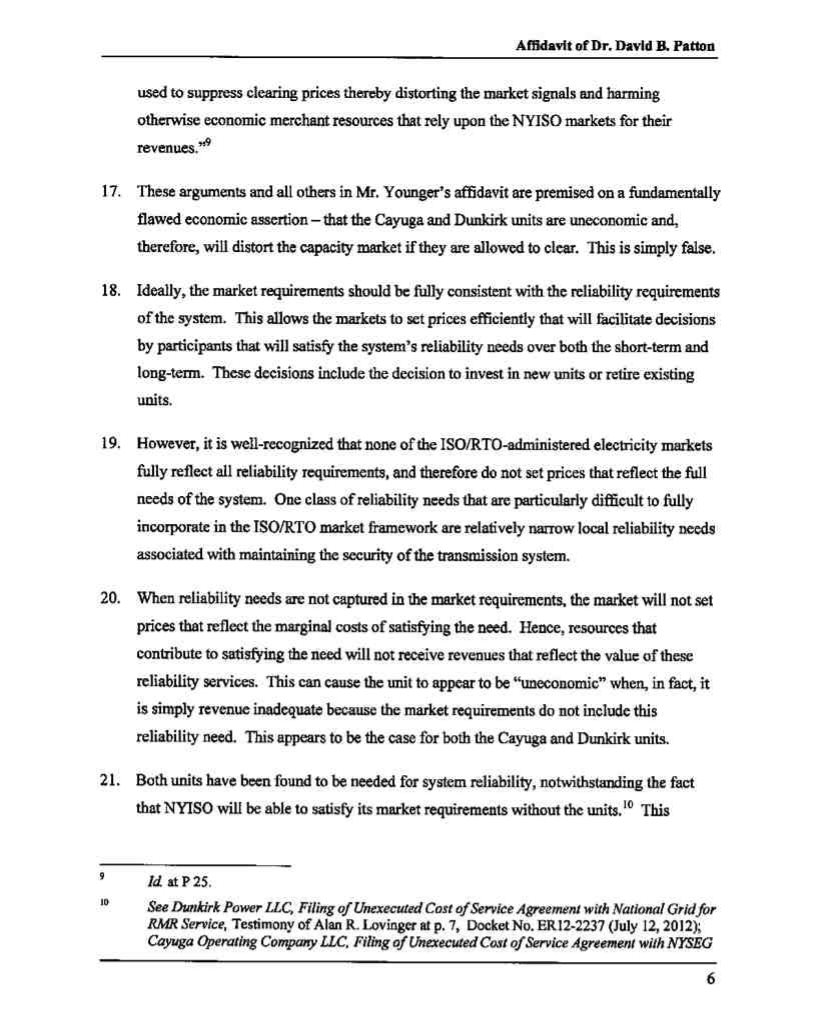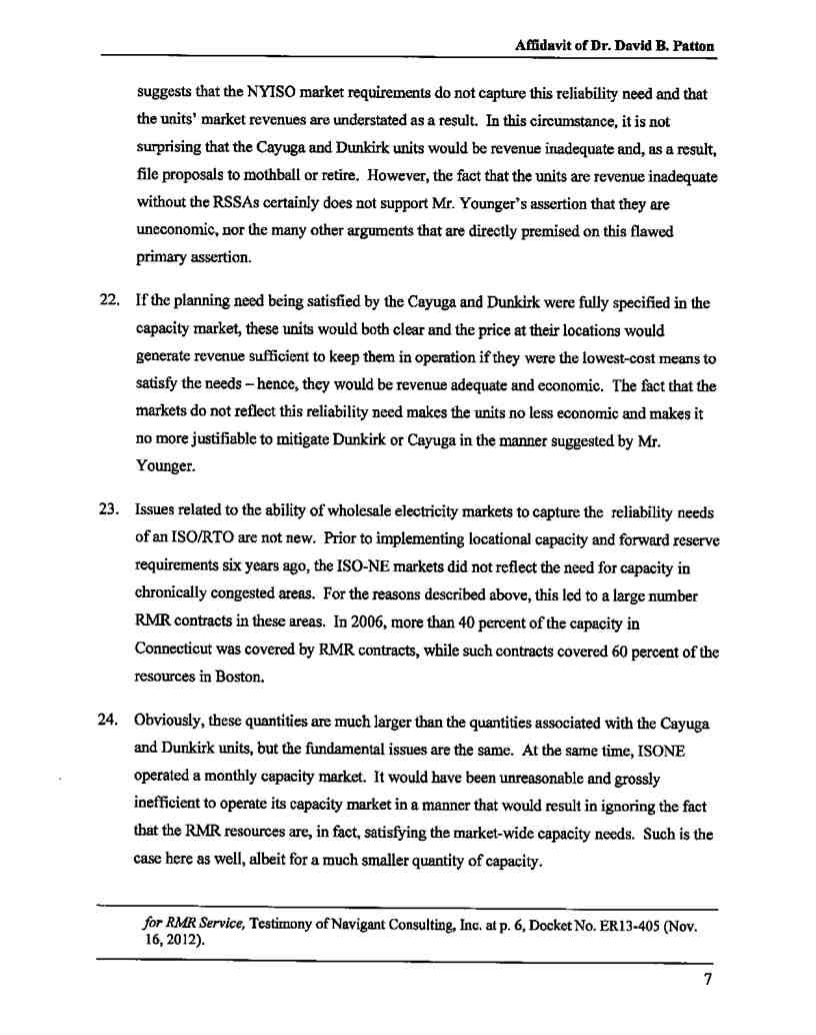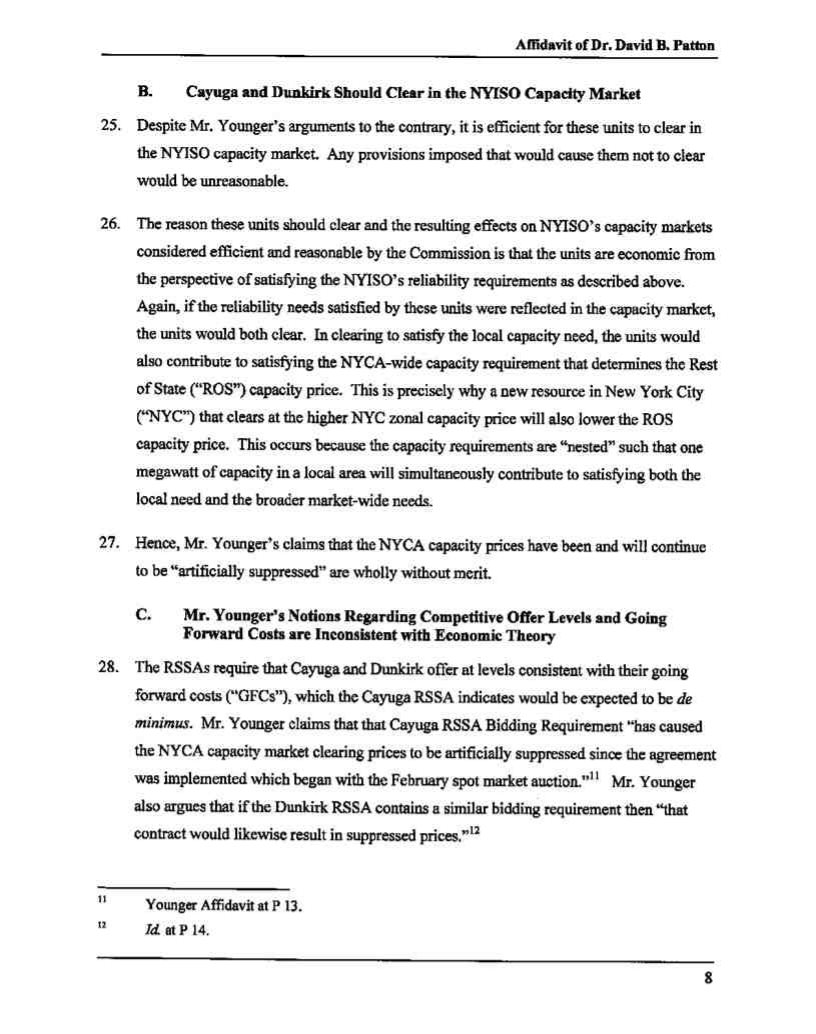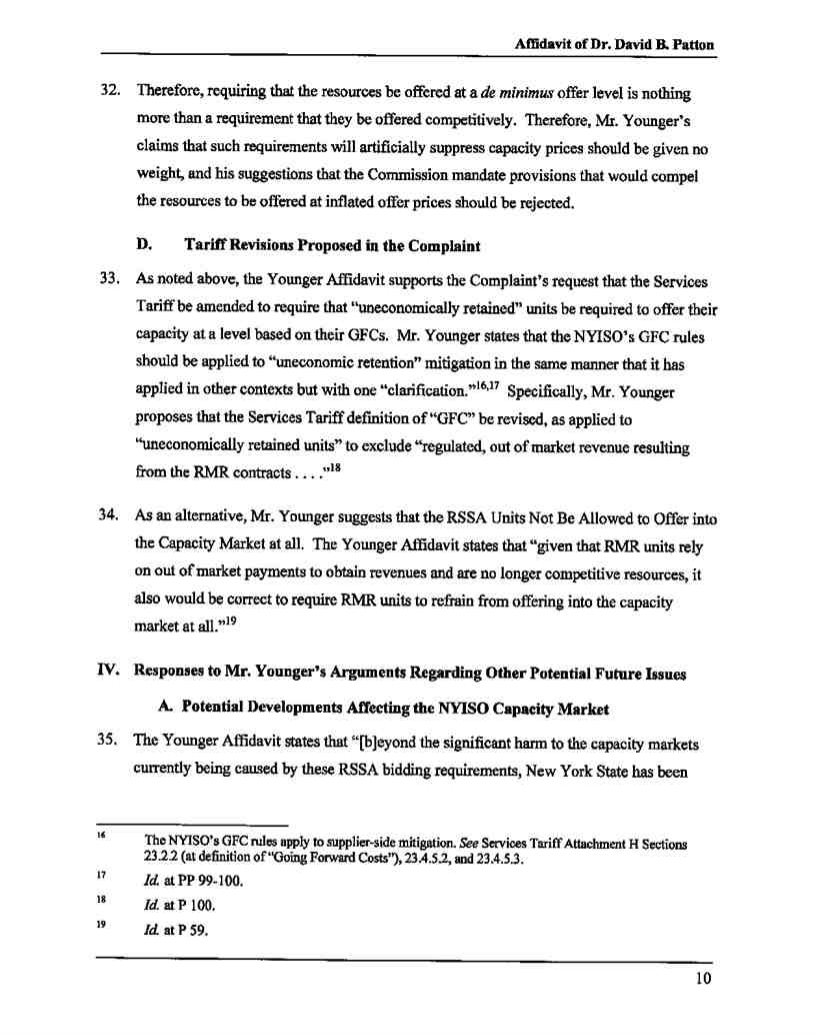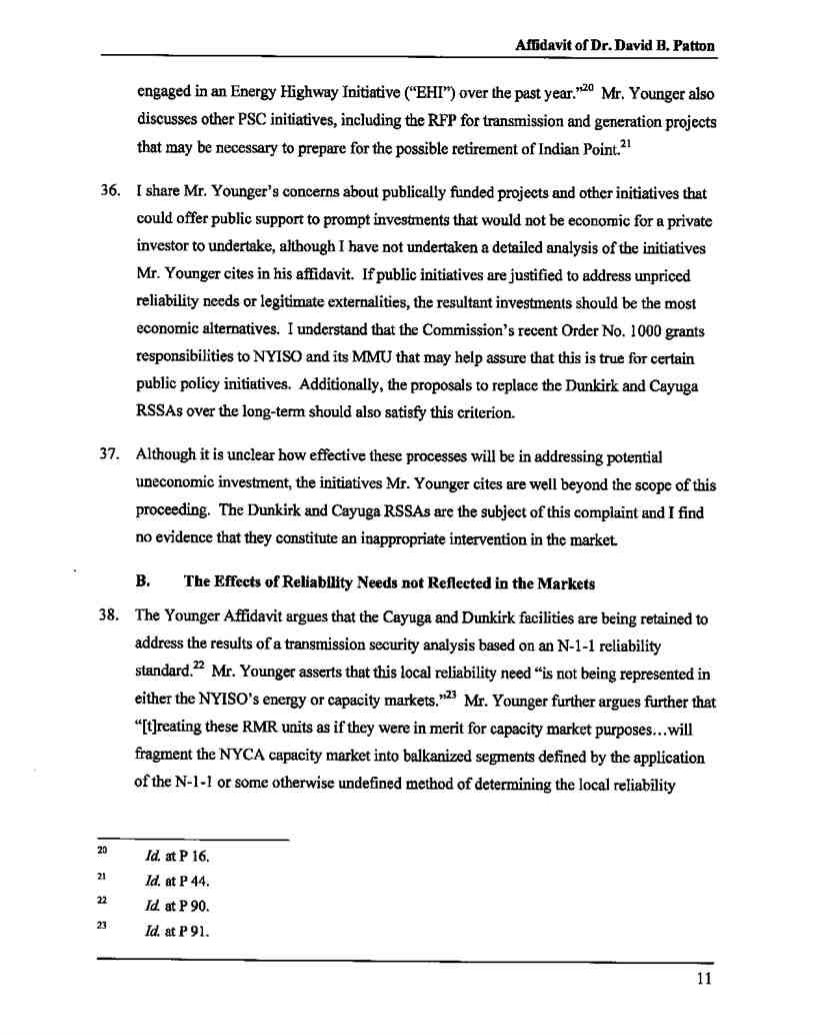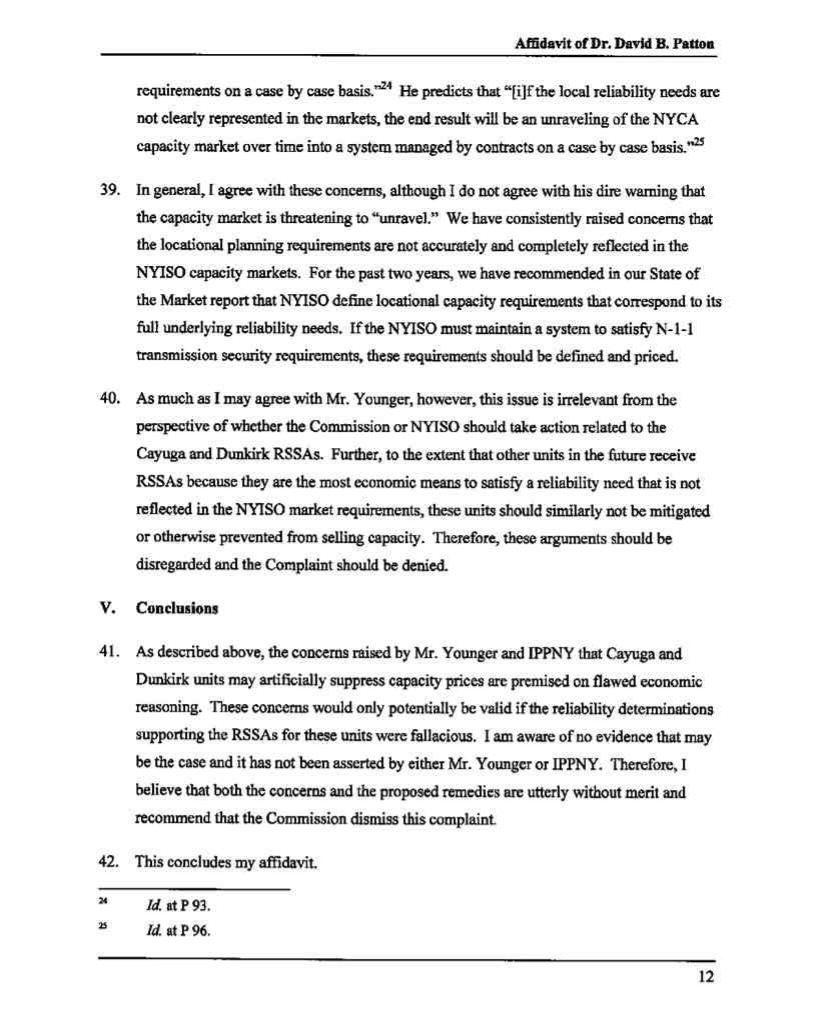UNITED STATES OF AMERICA
BEFORE THE
FEDERAL ENERGY REGULATORY COMMISSION
Independent Power Producers)
of New York, Inc.,)
)
Complainant,)
)
v.)
)
New York Independent System Operator, Inc.)
)
Respondent.)
ANSWER OF THE
Docket No. EL13-62-000
NEW YORK INDEPENDENT SYSTEM OPERATOR, INC.
Pursuant to Rule 213 of the Commission’s Rules of Practice and Procedure,1 the New
York Independent System Operator, Inc. (“NYISO”) respectfully submits this answer to the
Complaint Requesting Fast Track Processing of the Independent Power Producers of New York, Inc. (“Complaint”). The arguments advanced by the Independent Power Producers of New
York, Inc. (“IPPNY”) are wholly without merit. IPPNY has failed to satisfy its burden of proof under the Federal Power Act (“FPA”) and there is no basis for revising the NYISO’s Market
Administration and Control Area Services Tariff (“Services Tariff”).2 Accordingly, the
Complaint, including both of its alternative proposals to revise the Services Tariff and each of its other requests for relief, should be denied.
As discussed in Section II.A of this answer and in the affidavit of Dr. David B. Patton
(“Patton Affidavit”) (Attachment 1), the Complaint is predicated on fundamental flaws that
1 18 C.F.R. § 385.213 (2013).
2 Terms with initial capitalization that are not otherwise defined herein have the meaning set forth in the Services Tariff.
completely invalidate its arguments. These include IPPNY’s: (i) flawed economic assertions that
the Cayuga Operating Company, LLC (“Cayuga”) and Dunkirk Power, LLC (“Dunkirk”)
generating facilities are not economic; (ii) flawed notion of what constitutes a competitive
capacity market; (iii) flawed understanding that the Cayuga and Dunkirk units should not be
permitted to clear in the capacity market; and (iv) flawed assumption that a competitive offer
should include Going Forward Costs (“GFCs”) but exclude revenues from competitive
Reliability Services Support Agreements (“RSSAs”).3 Dr. Patton explains that it is reasonable
for the Cayuga RSSA, and to the extent that they include such a provision, the Dunkirk RSSAs,4
to require that generating facilities offer their “capacity value into the NYISO UCAP Auction at
a de minimis price in compliance with NYISO market rules” (“Cayuga RSSA Bidding
Requirement”).5
The Patton Affidavit further establishes that the only circumstances in which RSSAs
would raise competitive concerns would be: (i) when there is no legitimate need for a resource;
or (ii) the need addressed by an RSSA is already fully captured by capacity market requirements.
There is no dispute in this proceeding that the Existing RSSAs were entered into in order to
3 See Section II.A, below.
4 Under the first Dunkirk RSSA, Dunkirk agreed to provide reliability support services from two units rated at 100 MW each to National Grid from September 1, 2012 through May 31, 2013. Under the second Dunkirk RSSA, Dunkirk will provide service from one 100 MW unit from June 1, 2013 through May 31, 2015. See Complaint at 13-14. Solely for ease of reference, when this answer refers to the
Cayuga RSSA and to the “first” and “second” Dunkirk RSSAs collectively it refers to them as the
“Existing RSSAs.” The NYISO’s use of this drafting convention is not intended to indicate, and should not be construed as indicating, that the Dunkirk RSSAs contain bidding requirements comparable to the Cayuga RSSAs. As the Complaint notes, the portions of the Dunkirk RSSAs where bidding requirements would be located are confidential. See Complaint at 14.
5 The Complaint assumes, but IPPNY acknowledges that it does not know and has simply
inferred, that the Dunkirk RSSAs include a capacity bidding requirement that is identical or very similar to the one in the Cayuga RSSA. See Complaint at 13-14.
2
address legitimate reliability needs.6 Dr. Patton also explains that the reliability needs addressed
by the Existing RSSAs are not otherwise captured by NYISO capacity market requirements.7
The Patton Affidavit supports the NYISO’s position that “there has been, and currently is, no exercise of buyer-side market power or ‘artificial price suppression’ in the NYCA capacity market related to the ‘uneconomic retention’ of existing resources.”8 It also agrees with the
NYISO that “there is no reason for the Commission to require revisions to the Market
Administration and Control Area Services Tariff and that the Complaint should be rejected.”9
The Complaint’s remaining concerns about possible future threats to the NYISO capacity markets are unsubstantiated and it would be premature for the Commission to address them now. For example, the Complaint suggests that the Services Tariff must be revised to protect the
markets against additional RSSAs that may be executed in the future.10 Even if there are “Future
RSSAs” they would only be harmful if they fell into one of the two categories that Dr. Patton has
explained would raise competitive concerns. The Complaint briefly mentions various pending
New York State initiatives and proposed legislation that IPPNY asserts might someday threaten
the NYISO capacity markets. Cursory and unsupported statements regarding problems that
might arise in the future fall short of what is required to satisfy a complainant’s burden of proof.
6 See Patton Affidavit at P 12; Section I.C below. The NYISO uses the term “reliability need” in this answer in the same general way that the Patton Affidavit uses it and the Complaint uses the “system condition.” References herein to “reliability needs” should not be construed as necessarily referring to “Reliability Needs” as defined in the NYISO’s Open Access Transmission Tariff.
7 See Patton Affidavit at P 20.
8 Id. at P 15.
9 Id.
10 See Complaint at 33-38 and Attachment B - Affidavit of Mark D. Younger (“Younger Affidavit”) at P 29.
3
The NYISO and the independent Market Monitoring Unit (“MMU”)11 have the authority to
address any genuine market power issues that may arise. Further, there is no basis to presume
that the NYISO would not act to address future threats to the market as (and if) they appear.
Finally, although IPPNY is not legally barred from filing the Complaint, neither it nor its members (with one very limited exception,)12 made an effort to first address their concerns
through the NYISO stakeholder process. IPPNY’s approach is contrary to Commission policy
and precedent.13 This is especially true in this proceeding because IPPNY was aware of the core issues addressed by the Complaint for at least nine months14 and is now attempting to
unilaterally impose its own preferred tariff revisions on the NYISO-administered markets and
other stakeholders. IPPNY had ample time and opportunity to raise these issues in the NYISO
stakeholder process but never did.15 The Commission should take this opportunity to remind
IPPNY and its members that it strongly discourages such “end-runs” and will treat them with
disfavor. It should also encourage IPPNY to bring any remaining concerns about Future RSSAs, or other potential future issues, to the stakeholder process.
11 The independent MMU is Potomac Economics, Ltd. Dr. Patton is the President of Potomac Economics.
12 A single IPPNY member, TC Ravenswood, LLC (“TCR”) raised “uneconomic retention,”
including current and future RSSAs, as part of a proposal to revise the Services Tariff at one ICAP
Working Group Meeting (on April 30, 2013). When TCR next presented its proposal in the stakeholder process, it removed the aspects related to “uneconomic retention.” These very limited efforts by TCR do not excuse IPPNY’s clear and admitted failure to attempt stakeholder resolution of its issues, before
submitting its proposed tariff modifications in this Complaint.
13 See Section II.B, below.
14 See Complaint at 13 (noting August 16, 2012, New York Public Service Commission order approving the “Dunkirk Term Sheet” and stating that “the parties should have expected and we would expect that the capacity associated with Dunkirk Units 1 and 2 will be bid into the capacity market at a correspondingly de minimis price.”).
15 IPPNY is an active participant in the NYISO shared governance process as a guest, and IPPNY’s Managing Director is the Chair of the ICAP Working Group.
4
I.BACKGROUND
A.The NYISO and the Independent Market Monitoring Unit Strongly Support
Buyer-Side Market Power Measures When and Where they Are Needed
The NYISO recognizes the importance of having effective “supplier-side” and “buyer-
side” market power mitigation measures, when and where appropriate, to mitigate the potential
exercise of market power. When such measures are in place, the NYISO applies them
impartially and with equal diligence.16 New York has had buyer-side mitigation measures since
2008 to prevent “uneconomic entry” from artificially suppressing prices in New York City. The
MMU was a principal advocate for such measures both in New York and elsewhere.17 The
NYISO has proposed that the existing framework of buyer-side mitigation measures that
currently applies only to New York City (Load Zone J) be adapted for use in New Capacity
Zones,18 including the new “G-J” Locality that it has proposed to establish in pending Docket
No. ER13-1380-000.19 In short, the NYISO and the MMU both have a record of supporting the
creation of effective buyer-side mitigation rules that are appropriate and necessary.
That does not mean, however, that the NYISO, or the MMU, must necessarily support all proposals to extend buyer-side market power mitigation to encompass new forms of conduct. Both entities must determine whether a claimed incident of “artificial price suppression” really represents the exercise of buyer-side market power. They must also consider that over-
16 The NYISO recognizes that IPPNY’s members have disagreed with a number of the
implementation decisions that it has made under the uneconomic entry mitigation rules for New York City but notes that IPPNY strongly defended the NYISO’s application of them in Docket No. EL12-98-
000. See Motion to Intervene and Protest of Independent Power Producers of New York, Inc., Docket No. EL12-98-000 (filed Nov. 13, 2012).
17 See, e.g., Patton Affidavit at P 8.
18 See New York Independent System Operator, Inc., Further Compliance Filing, Docket No. EL12-360-001 (filed June 29, 2012).
19 See Proposed Tariff Revisions to Establish and Recognize a New Capacity Zone and Request for Action on Pending Compliance Filing, Docket No. ER13-1380-000 (filed April 30, 2013).
5
mitigation can do as much to impede necessary investments in new and existing capacity resources as under-mitigation.20
B. The NYISO and the Independent MMU Have Consistently Agreed that
“Uneconomic Retention” Is Not Causing Artificial Price Suppression in the NYISO Capacity Markets
In this proceeding, and in pending Docket No. ER13-405 (the “Cayuga RSSA
Proceeding”), IPPNY has advanced a novel but fundamentally flawed hypothesis that it
extrapolated from the Commission’s uneconomic entry precedent. According to IPPNY,
“uneconomic retention” is necessarily the economic equivalent of uneconomic entry.21 IPPNY also asserts that the Cayuga RSSA Bidding Requirement, and any similar requirement that may exist in the Dunkirk RSSAs, effectuate the exercise of buyer-side market power and thus are causing artificial price suppression in the NYCA Capacity markets.22
The NYISO is not aware of the Commission ever having approved a proposal to extend
the reasoning underlying its uneconomic entry precedent to encompass “uneconomic retention”
of existing resources and IPPNY does not point to any such rulings. IPPNY notes that the
Commission’s May 2010 Order23 indicated that buyer-side mitigation of existing resources
might conceivably be needed in the future. The May 2010 Order rejected a request for rehearing
20 See, e.g., New York Independent System Operator, Inc., 136 FERC ¶ 61,077 at P 28 (2011)
(“The whole purpose of the NYC mitigation program is to deter uneconomic entry, not economic entry”);
Midwest Independent Transmission System Operator, Inc., 122 FERC ¶ 61,172 at P 121 (accepting a
proposal that “both protects consumers from market power, while also avoiding over-mitigation that can
cause reliability problems to the extent that it keeps capacity out of the market over the longer term”);
Midwest Independent Transmission System Operator, Inc., 123 FERC ¶ 61,297 at P 63 (2008) (finding
that the conduct threshold proposed “strikes an appropriate balance between the need to protect
consumers from the exercise of market power and the goal of avoiding over-mitigation that may keep
capacity out of the market”).
21 See Complaint at 20-21; Younger Affidavit at 3, 27, 70-71, 77-83.
22 Complaint at 38.
23 See Complaint at 4; see also New York Independent System Operator, Inc., 131 FERC ¶ 61,170 (2010) (“May 2010 Order”).
6
that called for existing resources to be subject to buyer-side mitigation. The Commission stated
that:
We reject Ravenswood’s claim that a change in contractual or financial
arrangements pertaining to an existing generation facility should transform that
facility into a unit subject to new entry mitigation rules. As we concluded earlier,
new entry mitigation is intended to deter the construction of uneconomic capacity
and such deterrence would not apply in this case. We understand that
Ravenswood remains concerned that entities with buyer market power may have
an incentive to suppress market clearing prices below the competitive level by
retaining uneconomic capacity that should be mothballed or retired, and that they
might attempt to exercise this market power through contractual means, i.e., that
new uneconomic entry is not the only mechanism available for generators to
exercise such market power. However, we find the possibility for such action too
speculative at this point to require an immediate remedy. We conclude that the
evidence to date supports only the offer floor mitigation for uneconomic new
entry by generators and SCRs (see discussion below) that this order addresses.
Ravenswood’s concerns should be addressed in the annual report prepared by
the independent market monitor to the extent the monitor finds evidence to
support their concerns.24
The MMU, however, has never found evidence that would justify adopting rules to
mitigate the “uneconomic retention” of existing resources either before or after the issuance of the May 2010 Order. None of its annual State of the Market Reports identify any possible need for tariff changes or make any other recommendations related to “uneconomic retention.” This includes the recent 2012 State of the Market Report25 which was issued well after IPPNY first expressed concerns about the RSSAs.26
As noted in the Patton Affidavit, the MMU has been aware of the Existing RSSAs, and IPPNY’s claims regarding them since it was first determined that they were needed for
24 See May 2010 Order at P 43 (emphasis added).
25 See 2012 State of the Market Report for the New York ISO Markets (April 2013) available at
<http://www.nyiso.com/public/webdocs/markets_operations/documents/Studies_and_Reports/Reports/M
arket_Monitoring_Unit_Reports/2012/NYISO2012StateofMarketReport.pdf>.
26 See Section I.D below.
7
reliability.27 The MMU has consistently advised the NYISO that those claims are fundamentally flawed and that the Cayuga RSSA Bidding Requirement, and any other comparable requirement that may exist in the Dunkirk RSSAs, are efficient given the identified need not addressed by the market.28 The MMU has never suggested that the NYISO should take any action to “remedy” IPPNY’s concerns or recommended Services Tariff revisions. The MMU’s reasoning is set forth in the Patton Affidavit and in Section II.A of this answer.
The NYISO has previously noted that it was “not a party to, and was not involved in the development of ” the Cayuga RSSA.29 It likewise was not a party to or involved in the
development of the Dunkirk RSSAs. Nevertheless, the NYISO has monitored the Commission’s proceedings involving the Existing RSSAs and their impacts on its markets. The NYISO’s
Market Mitigation and Analysis department has consistently agreed with the MMU’s
conclusions and recommendations regarding the Existing RSSAs.
C.There Is No Question that the Existing RSSAs Address Legitimate Reliability
Needs
The Complaint notes that the Dunkirk RSSAs were executed because the local New York
Transmission Owner, i.e., Niagara Mohawk Power Corporation d/b/a National Grid (“National
Grid”) “conducted an analysis that found that the loss of Units 1 and 2 of the Dunkirk Facility
would have adverse reliability impacts.”30 Similarly, it observes that the Cayuga RSSA was
instituted because the relevant local New York Transmission Owner, i.e., New York State
Electric & Gas Corporation (“NYSEG”), “found that the Cayuga Facility would need to address
27 See Patton Affidavit at P 9.
28 Id. at PP 9, 39.
29 See Limited Comments of the New York Independent System Operator, Inc., Docket No. ER13-
405-000 (filed Jan. 22, 2013).
30 Complaint at 11.
8
an identified system condition.”31 IPPNY has “acknowledged the need to address identified system conditions” and made it clear that its objection to the RSSAs has to do solely with its theory that the RSSAs’ bidding requirements are resulting in artificial price suppression in the NYCA capacity market.32
D. IPPNY Had Ample Time and Opportunity to Raise the Issues Addressed in
the Complaint Through the NYISO’s Shared Governance Process
As the NYISO noted in its Initial Answer Opposing Fast-Track Processing in this
proceeding, the purported market harm alleged by IPPNY (i.e., the supposed “artificial
suppression” of NYCA capacity prices) supposedly began with the February 2013 ICAP Spot
Market Auction.33 The results of that auction were posted in January 2013.
IPPNY has been aware of the Dunkirk and Cayuga RSSAs, which the Complaint cites as the cause of the alleged “artificial suppression” of prices,34 since at least August 2012. As the Patton Affidavit demonstrates, and as discussed below, IPPNY’s arguments concerning the
Existing RSSAs have no economic underpinning. Despite IPPNY’s dire warnings of the adverse
consequences that the Existing RSSAs will supposedly bring, it has inexplicably failed to address
the root of its concerns, i.e., the content of certain contract terms approved in the New York
31 Id. at 15.
32 Id. at 17 (citing Protest of Independent Power Producers of New York, Inc., Docket No. ER13-
405-000 (filed Jan. 7, 2013); Request for Expedited Order Prohibiting Implementation of an Unapproved Contract for Reliability Must Run Service Subject to FERC Jurisdiction and Limited Answer of
Independent Power Producers of New York, to Comments of the New York Independent System Operator, Inc., Docket No. ER13-405-000 (filed Jan. 25, 2013). See also Complaint at 27 (“That the Cayuga and Dunkirk Facilities are needed to address an identified system condition does not alter the fact that they are uneconomic ”). See also Younger Affidavit at PP 34-36 (acknowledging that the Existing RSSAs
were executed in response to “system conditions”).
33 See Initial Answer of the New York Independent System Operator, Inc. Opposing Fast Track Processing, Docket No. EL13-62-000 at 4 (filed May 13, 2013); See also Complaint at 21.
34 Complaint at 41-42; see also Younger Affidavit at P 27.
9
Public Service Commission (“NYPSC”) proceeding. In fact, IPPNY affirmatively demurred when it had an opportunity to comment before the NYPSC.35
Issues relating to the Dunkirk RSSAs have been pending before this Commission since
July of 2012, while the Cayuga RSSA Proceeding commenced in November 2012.36 IPPNY is a
party in both of those proceedings. It filed a lengthy protest, which included another affidavit by
Mr. Younger, in the Cayuga RSSA Proceeding. IPPNY acknowledges that its protest included
arguments regarding the supposedly price-suppressive effects of the Cayuga RSSA Bidding
Requirement that are very similar to those included in the Complaint.37 TCR, the only IPPNY
member to have mentioned Existing RSSAs issues in the stakeholder process, also filed
comments filed in the Cayuga RSSA Proceeding. The NYISO stated four months ago that
IPPNY should have first brought these concerns to the stakeholder process.
Accordingly, IPPNY became aware of the core issues addressed by the Complaint, and developed lengthy arguments concerning them, more than four months ago.38 It had ample time to avail itself of the NYISO stakeholder process. IPPNY simply failed to do so. 39
35 See IPPNY’s July 30, 2012 letter in NYPSC Case No. 12-E-OI36 at 3
http://documents.dps.ny.gov/public/Common/ViewDoc.aspx?DocRefId={C385A3B2-5E7C-4391-A4EB-
8E0D0C8414CE} IPPNY also has not followed the usual course for challenging NYPSC determinations, which is under Article 78 of the New York Civil Practice Law and Rules.
36 The proceeding to consider issues related to the Cayuga RSSA in Docket No. ER13-405 was initiated on November 16, 2012 and the RSSA was filed on January 3, 2013. The proceeding to consider issues related to the Dunkirk RSSAs in Docket No. ER12-2237 was initiated on July 12, 2012.
37 See Complaint at 40 (“IPPNY and other parties have raised similar concerns about the impact of the offer requirements set forth in the Cayuga RSSA on prices in the NYCA ICAP Spot Market
Auction in the ER13-405 proceeding...”).
38 Limited Comments of the New York Independent System Operator, Inc. at 3, Docket No. ER13-
405-000 (filed Jan. 22, 2013).
39 As stated above at n.11, only one IPPNY member, TCR, has even attempted to raise anything related to “uneconomic retention” in the NYISO’s stakeholder process.
10
Specifically, the Patton Affidavit states that in an ideal market, “market requirements
should be fully consistent with the reliability requirements of the system.”44 Such markets
would set efficient prices and Market Participants would be able to make economic decisions, including investment and retirement decisions, that will satisfy the system’s reliability needs
over both the short-term and long-term. The Patton Affidavit explains that no ISO/RTO market, including the NYISO’s markets, fully reflect all reliability requirements. Thus, no market today sets prices that fully reflect all system needs.45
Relatively narrow local reliability needs associated with maintaining the security of the
transmission system are particularly difficult to fully account for within existing organized
markets. When such needs are not captured in a market’s requirements, the market will not set
prices at a level that reflects the marginal costs of satisfying the need. Thus, a resource that
contributes to satisfying the need may not receive revenues that reflect the full value that its
services provide. In this situation, a capacity resource can appear to be “uneconomic” when, in
fact, it is economic, but revenue inadequate, because the market requirements do not include the
reliability needs.
Dr. Patton believes that both the Cayuga and Dunkirk units fall into this category.46 As
noted above in Section I.C, IPPNY does not dispute that both units have been found to be needed
for system reliability.47 This is the case even though the NYISO will be able to satisfy its market
requirements without them. This suggests that the market revenues the units are receiving is
44 Id. at P 18.
45 Id. at P 19.
46 Id. at P 20.
47 See also Patton Affidavit at P 41 (noting that Mr. Younger’s “concerns would only potentially
be valid if the reliability determinations supporting the RSSAs for these units were fallacious. I am aware
of no evidence that may be the case and it has not been asserted by either Mr. Younger or IPPNY.”).
12
understated, that they would be revenue inadequate, and thus would reasonably be expected48 to seek to mothball or retire.49
The Patton Affidavit concludes that the mere fact that the Cayuga and Dunkirk units
would be revenue inadequate but for the Existing RSSAs does not support the Complaint’s
assertion that they are uneconomic, or the many other arguments that are entirely dependent on that assertion.50 Dr. Patton states the revenue inadequacy “makes the units no less economic and makes it no more justifiable to mitigate Dunkirk, Cayuga, or other units similarly situated that might receive an RSSA in the manner suggested by Mr. Younger.”51
2. It Is Efficient and Reasonable for the Cayuga and Dunkirk Units that
Are Covered by Existing RSSAs to Clear in the Capacity Market
The Complaint contends that it is inappropriate for RSSAs to require that capacity
resources offer into the NYISO capacity markets at “de minimus” levels.52 According to
IPPNY, capacity resources that would have exited the market but for an RSSA should instead have to offer at the level of their GFCs or, in the alternative, be excluded from the capacity market entirely.53
48 The NYISO notes that Mr. Younger is speculating when he suggests that the Cayuga and
Dunkirk units would have necessarily permanently exited the market but for the Existing RSSAs. See Younger Affidavit at P 19. See also Younger Affidavit at P 62 (asserting that whether the Cayuga and Dunkirk RSSAs opted to mothball or retire was “a distinction without a difference.”)
49 See Patton Affidavit at P 21. See Dunkirk Power LLC, Filing of Unexecuted Cost of Service
Agreement with National Grid for RMR Service, Testimony of Alan R. Lovinger, Docket No. ER12-2237 at 7 (filed July 12, 2012); Cayuga Operating Company LLC, Filing of Unexecuted Cost of Service
Agreement with NYSEG for RMR Service, Testimony of Navigant Consulting, Inc., Docket No. ER13-405 at 6 (filed Nov. 16, 2012).
50 See Patton Affidavit at P 21.
51 Id. at P 22.
52 See, e.g., Complaint at 4, 17, 21, 25-26, 30 and 33.
53 Patton Affidavit at P 25.
13
4.The Complaint’s Arguments Regarding the Proposed Price
Suppressive Impacts of the Existing RSSAs Are Irrelevant Because They Are Predicated on Invalid Economic Assumptions
The Complaint, and the Younger Affidavit, make lengthy arguments concerning the
financial impacts of the supposed “artificial price suppression” that they blame on the Existing
RSSAs. The Complaint claims that the Cayuga RSSA Bidding Requirement alone has caused
NYCA spot market capacity clearing prices to be “artificially suppressed” at a level equal to
“approximately $7/kW-year to $8/kW-year, all else equal.”63 The Younger Affidavit notes that
in the “four NYCA spot market auctions since the Cayuga RSSA became effective, the market
clearing prices were $2.65/kW-month, $2.09/kW-month, $1.50/kW-month and $3.01/kW month
respectively.”64 It further contends that the Cayuga Bidding Requirement alone will cost Rest of
State capacity suppliers more than $77 million.65 The Complaint and the Younger Affidavit
claim that these losses will immediately and directly injure capacity suppliers, indirectly harm all
Market Participants, and ultimately call the “sustainability” of the capacity markets into
question.66
The NYISO is not addressing these arguments other than to note that they would only be relevant to the extent that the Existing RSSAs are causing “artificial price suppression.” Because Dr. Patton has demonstrated that the Existing RSSA are not harming the markets there is no
“impact” issue to discuss. The NYISO also notes that the Younger Affidavit did not use the
correct clearing price for May 2013 of $5.76/kW-month.67
63 Complaint at 4, 26, 41; Younger Affidavit at P 13.
64 Younger Affidavit at P 49.
65 Id. at P 27; see also Complaint at 41.
66 See Complaint at 26, 39; Younger Affidavit at PP 8, 20, 28, 48, 98.
67 See Younger Affidavit at P 49.
16
B.The Commission Need Not Address IPPNY’s Concerns Regarding Possible
Future RSSAs, New York State’s Energy Highway Initiative, or Other Actions that New York State Might Pursue in the Future
Beyond its concerns with the Existing RSSAs the Complaint suggests68 that there may be
additional Future RSSAs that would exacerbate “artificial price suppression” and potentially
“fragment,” “balkanize,” or even “unravel” the NYISO capacity markets.69 The Complaint also
states that while it is “focused on” issues associated with the “uneconomic retention” of existing
resources pursuant to RSSAs that “the Commission should be aware that there are also a number
of efforts underway in New York that threaten similar harm through subsidized new entry into
the Rest of State region.”70 The Complaint refers to the Governor’s “Energy Highway
Initiative,” various pending NYPSC proceedings, and proposed state legislation, as examples of
such future threats.71
IPPNY’s warnings that Future RSSAs may proliferate are not a sufficient basis for
granting the Complaint. IPPNY’s argument that Future RSSAs would harm the market is a
product of its flawed assumption that RSSAs with de minimis bidding requirements will
necessarily result in “artificial price suppression.” But the Patton Affidavit is clear that RSSAs
will not normally be anti-competitive and capacity resources that enter into them should
normally be allowed to clear in the market and to offer their capacity at a price level that
accounts for their RSSA revenues.72 The Patton Affidavit also rejects suggestions that RSSAs
68 See Complaint at 28-32; See also Younger Affidavit at P 31 (“Thus, as a preliminary matter, I would note that while only two RSSAs are currently in place in New York there is a significant potential that more may become necessary.”).
69 Complaint at 31-32.
70 Id. at 18.
71 Id. at 18-20.
72 See Patton Affidavit at P 49 (“Further, to the extent that other units in the future receive RSSAs
because they are the most economic means to satisfy a reliability need that is not reflected in the NYISO
17
will cause the capacity markets to “unravel.” Future RSSAs will only cause artificial price
suppression if they do not address a legitimate reliability need or if the need that they address is already fully captured by capacity market requirements so that prices will account for the need. If the NYISO were to identify a Future RSSA that appeared to violate one of Dr. Patton’s criteria it would investigate and take any necessary action under its existing tariff authority.
IPPNY’s concerns about various pending or potential New York State initiatives should
likewise not be addressed. IPPNY’s brief references to them are limited and conclusory and do
not satisfy its burden of proof under the FPA. Even if the Commission thought there was merit
in IPPNY’s concerns about New York State initiatives, Dr. Patton has refuted the underlying
economic assumptions which IPPNY’s two proposed alternative tariff revisions were fashioned
to address. Moreover, unlike its arguments regarding Existing RSSAs, IPPNY does not claim
that pending or potential future New York State initiatives have been or are currently harming
suppliers or the capacity markets. It simply claims that they may cause harm in the future.73 At
a minimum, for the reasons set forth in Section II.D below, the Commission ought to direct
IPPNY to raise its concerns about these initiatives in the stakeholder process in the first
instance.74 By rejecting these aspects of the Complaint, the Commission would recognize the
market requirements, these units should similarly not be mitigated or otherwise prevented from selling capacity.”).
73 This proceeding is distinguishable in many ways from the 2011 proceedings addressing the PJM Interconnection, L.L.C. ("PJM") Minimum Offer Price Rule ("MOPR") in which the Commission acted in response to certain initiatives by PJM states that allegedly would have artificially suppressed PJM capacity prices. The most important is that the "triggering event" that prompted Commission action in the 2011 MOPR proceedings was the enactment of legislation by New Jersey that would have
imminently impacted PJM's capacity auctions.
74 The NYISO is aware that the Patton Affidavit indicates that Dr. Patton shares some of Mr.
Younger’s concerns regarding potential future “initiatives that could offer public support to prompt
investments that would not be economic for a private investor to undertake . . . ,” See Patton Affidavit at
PP 36, 40 but notes that Dr. Patton supports the NYISO’s position that such issues are outside the scope
of this proceeding and that the Complaint should be denied. See Patton Affidavit at PP 15, 37, 42.
18
NYISO’s existing authority to address any genuine market power issues that may arise rather
than presuming, without any basis, that the NYISO would do nothing. To adopt a
comprehensive set of mitigation rules, developed by a single class of Market Participants, to
address potential problems that might potentially emerge in the future would be to err too far on the side of over-mitigation.
C. Because the Existing RSSAs Do Not Result in “Uneconomic Retention”
Buyer-Side Market Power or “Artificial Price Suppression” in CommissionJurisdictional Markets There Is No Need for Tariff Revisions or Other
Commission Action
The Complaint asks that the NYISO be required, immediately upon the issuance of a
Commission order, to “either (1) exclude uneconomic existing resources that would have exited
the market but for out-of-market payments, including but not limited to payments under RMR-
type agreements like the RSSAs, from the capacity market altogether, or (2) require capacity
offers no lower than GFCs from such resources.” It would then allow the NYISO twenty days to
file the necessary tariff revisions. The Complaint also requests that the NYISO be compelled to
“ensure that RMR resources are only called upon to operate to the extent needed to address the
reliability concerns underlying the RMR designation, and that RMR-type mechanisms remain in
place for limited time periods and only until such time as longer-term generation or transmission
solutions are put in place.”75
For the reasons specified above, there is no basis for the Commission to grant any of the
relief requested by IPPNY or to direct any other tariff revisions. The Patton Affidavit
demonstrates that the Complaint’s arguments regarding Existing RSSAs and Future RSSAs are
75 Complaint at 5. See also Complaint at 36-37 and n. 141 (stating that because these tariff
revisions are not as “time sensitive” as others unilaterally proposed by IPPNY that the NYISO should be afforded as long as ninety days to address them).
19
“utterly without merit.” It would be premature to impose tariff revisions to address assorted
other unfinished or future New York State initiatives referenced in the Complaint.
The Commission has been clear that it will not “pass judgment on state policies and objectives” but will protect Commission-jurisdictional capacity markets from potential state efforts to use buyer-side market power to disrupt competitive market signals.76 The Complaint attempts to present this proceeding as an instance where such Commission action is necessary. The Commission should reject that notion. The Complaint fails to show that “artificial price suppression” has taken, or is currently taking, place in the NYCA capacity markets. It does not show that there is an imminent threat of such harm occurring in the future or that the NYISO and/or the MMU would fail to utilize existing tools to mitigate actual future harms.
Consequently, the Complaint should be denied in its entirety.
D.The Commission Should Discourage IPPNY from Attempting to Circumvent
the NYISO Stakeholder Process
The Complaint’s substantive defects are addressed in Section II.A above and in the
Patton Affidavit. Even if the Complaint had merit, however, IPPNY’s decision to file it without
making an effort to first raise its concerns through the NYISO stakeholder process would violate
Commission policy and precedent. It would also be contrary to agreements establishing the
authority and governance of the NYISO that IPPNY’s members have executed.77 It is true that
the FPA does not expressly prohibit parties from filing complaints when they have ignored the
policies and precedent endorsing the use of stakeholder processes. But the Commission should
use the opportunity presented by the submission of a filing with deficiencies that could have
76 See, e.g., PJM Interconnection, L.L.C. 143 FERC ¶ 61,090 at P 54 (2013) (citing PJM Interconnection, L.L.C. 137 FERC ¶ 61,145 at P 89 (2011)).
77 See ISO Agreement §§ 7.01-7.13, 11.01, and 19.01.
20
been identified through stakeholder discussions, to remind IPPNY and others that it views attempts to bypass such discussions with disfavor.
The Commission has repeatedly discouraged attempts to make “end-runs” around
ISO/RTO governance processes by proposing tariff changes that have not had the benefit of
stakeholder vetting. 78 It does so because it recognizes that stakeholder discussions can help to
improve the quality of tariff filings, better balance the interests of the various sectors impacted
by proposed changes, and reduce the number and severity of disputed issues.79 The NYISO’s
“shared governance” arrangements arguably give stakeholders a greater role in shaping tariff
revisions than they have in any other market. In particular, under the ISO Agreement, the
NYISO’s tariffs may only be revised pursuant to Section 205 of the FPA if the revision has been
approved by a super-majority of the stakeholder Management Committee and by the NYISO’s
78 See, e.g., ISO New England Inc., 130 FERC ¶ 61,145, at P 34 (2010) (“we encourage parties to
participate in the stakeholder process if they seek to change the market rules...”); ISO New England Inc.,
125 FERC ¶ 61,154 at P 39 (2008) (directing that unresolved issues be addressed through the stakeholder
process); ISO New England, 128 FERC ¶ 61,266 at P 55 (2009) (declining to grant a party’s specific
request for relief because the Commission “will not ... circumvent that stakeholder process”); New York
Independent System Operator, Inc., New York Transmission Owners, 126 FERC ¶ 61,046, at PP 53-54
(2009) (directing that a proposal be “presented to and discussed among … stakeholders and filed as a
section 205 proposal, not unilaterally presented to the Commission”); New England Power Pool,
107 FERC ¶ 61,135 at PP 20, 24 (2004) (declining to accept changes proposed for the first time in a
FERC proceeding by an entity that participated in the stakeholder process because the “suggested
revisions have not been vetted through the stakeholder process and could impact various participants”).
79 See, e.g., California Independent System Operator, Inc., 143 FERC ¶ 61,087 at P 73 (2013)
(directing the development of a “long-term solution through the stakeholder process” because it will allow
the ISO “and the market participants to thoroughly evaluate the benefits and costs of various alternatives,
and development the most efficient long-term solution”); ISO New England Inc., 130 FERC ¶ 61,145 at
P 34 (2010) (refusing to address stakeholder concerns that were the subject of ongoing stakeholder
process and encouraging “parties to participate in the stakeholder process if they seek to change the
market rules”); Consolidated Edison Company of New York, Inc., 95 FERC ¶ 61,216 at 61,719 (“First,
ConEd circumvented the NYISO stakeholder process by unilaterally filing revisions to the in-City
mitigation measures. ConEd’s failure to use the NYISO stakeholder process has resulted in vigorous
opposition to its proposal. We strongly encourage market participants to use the stakeholder process,
especially in this type of situation, i.e., where a market participant seeks to modify market measures that
impact all market participants”).
21
independent Board of Directors.80 While interested parties may ask that tariff changes be
imposed under FPA Section 206, the Commission has been clear that such filings are disfavored when the NYISO stakeholder process has not been exhausted.81
IPPNY effectively acknowledges that the Complaint represents an end-run around the
stakeholder process.82 IPPNY attempts to justify its conduct based on its supposed need for
expedited Commission action, but that claim is baseless. As noted above, in Section I.D, IPPNY has been aware of the issues in this proceeding since last year and made multiple filings with the Commission in late 2012 and early 2013 concerning them. Thus, the only reason why
“expedited action” would be needed with respect to the Existing RSSAs, even if IPPNY’s claims regarding them had economic merit, would be IPPNY’s own delay.
IPPNY claims that it “deferred” to the stakeholder process by narrowing the issues raised in the Complaint as much as possible and by only requesting “relief narrowly tailored to the
immediate and ongoing threat to the capacity market.... ”83 Neither of these “defenses” is
valid. It is unclear in what way the Complaint’s challenge to the Existing RSSAs, and any future
RSSAs or other possible future state initiatives, or its requests for relief regarding them, could be
said to be “limited.” The Complaint proposes two alternative tariff proposals in response to the
supposed problems that the Existing RSSAs allegedly create. It is not “deference” to the
stakeholder process to assert that stakeholders still have a right to litigate before the Commission
80 See ISO Agreement § 7.01. The one exception to this requirement, which is not relevant here, is the rule allowing the NYISO to propose temporary tariff changes under Section 205 when “exigent circumstances” exist. See ISO Agreement § 19.01.
81 See, e.g., Niagara Mohawk Power Corp. v. New York State Reliability Council and New York Independent System Operator, Inc., 114 FERC ¶ 61,098 at P 1 (2006) (“For the reasons described below, we will exercise our discretion and require that National Grid first exhaust its methods of resolving this dispute within Reliability Council and NYISO before filing a complaint with the Commission. Thus, we will dismiss the Complaint, without prejudice”).
82 Complaint at 37-38.
83 Id. at 38.
22
after a complainant bypasses the process.84 If IPPNY had truly meant to “defer” to the stakeholder process it would have tried to make use of it.
IPPNY also compares the unilateral action it took by filing the Complaint with an
emergency action that the NYISO took in a supposedly “analogous situation.” The difference is that the NYISO acted to address an actual and immediate threat to the markets while IPPNY’s actions are predicated on fundamentally flawed economic assumptions. In addition, the NYISO and MMU are both independent, not-for-profit entities that the Commission has tasked with important market monitoring functions. Neither has any incentive to favor any individual
stakeholder or class of stakeholders.85 Thus, the NYISO’s and the MMU’s strong opposition to IPPNY’s tariff proposals should be accorded great weight.
IPPNY’s argument that the FPA’s mandate against unlawful rates cannot be overruled by
stakeholder process considerations must also be rejected.86 As stated above, the fact that an
84 Id.
85 See, e.g., Niagara Mohawk Power Corp. v. FERC, 452 F.3d 822, n.5 (D.C. Cir. 2006) (noting that “NYISO is an independent entity and is governed by a board of directors, none of whom is affiliated with market participants”); Atlantic City Elec. Co. v. FERC, 295 F.3d 1, 5 (D.C. Cir. 2002) (noting that ISOs “have no financial stake in any power market participant”); New York Indep. Sys. Operator, Inc.,
133 FERC ¶ 61,072, PP 26-27 (2010) (finding that the NYISO operates “independent of any market
participant or class of market participants”); Cent. Hudson Gas & Elec. Co., 88 FERC ¶ 61,229 (1999)
(confirming that NYISO had adopted rules requiring it to be independent from, and have no financial
interests in the economic performance of, any market participant). See also New York Independent
System Operator, Inc., 129 FERC ¶ 61,164 (2009) (confirming NYISO’s compliance with Order No.
719’s stakeholder “responsiveness” requirements).
86 See, e.g., Braintree Elec. Light Dept. v. ISO New England, Inc., 128 FERC ¶ 61,008 at P 50
(2009) (“The Commission does not find reliance on the stakeholder process to be an impermissible
delegation of authority. The Commission may refer, and has referred, a matter to a stakeholder process in
any number of circumstances. In particular, a stakeholder process is appropriate when unresolved issues
may be better addressed in a forum featuring broad stakeholder input, and where a solution can be better
tailored to meet regional needs through broad input from interested participants that may not otherwise
participate in a Commission proceeding. Because the Commission will ultimately review and act on any
resulting proposal, there is no issue with respect to the delegation of Commission authority”); El Segundo
Power, LLC, 95 FERC ¶ 61,159 at 61,157 (2001) (rejecting an argument that the “stakeholder process
may adversely affect the Commission’s statutory responsibilities under the FPA finding that “the
stakeholder process allows potentially affected parties to voice their concerns regarding a rate or term of
service prior to the filing of the rate or term with the Commission. If consensus is not reached, then a
23
Attachment 2
Compliance with Commission Rule 213(c)(2)
A. Specific Admission and Denials of Material Allegations
In accordance with Commission Rule 213(c)(2)(i), to the extent practicable and to the
best of the NYISO’s knowledge and belief at this time, the NYISO admits or denies below the
material factual allegations in the Complaint. To the extent that any fact or allegation in the
Complaint is not specifically admitted below, it is denied. Except as specifically stated herein,
the NYISO does not admit any facts in the form or manner stated in the Complaint.
1.Denials
•The NYISO denies that prices in the NYCA capacity market have been, or currently
are being, “artificially suppressed” by below cost capacity offers from resources that would have exited the market but for out-of-market revenues under RSSAs, or for any other reason. (Complaint at 1-2, 4, 20)
• The NYISO denies that the Commission must act to protect the market from the
“artificial price suppression” supposedly caused by “de minimis” offer requirements in RSSAs by amending the Services Tariff. (Complaint at 2, 21)
• The NYISO denies that the Cayuga and Dunkirk units are “uneconomic” because
they have RSSAs to retain them to address a reliability requirement. (Complaint
at 4, 27)
• The NYISO denies that the considerations that previously led the Commission to
decline to adopt buyer-side market power mitigation measures applicable to existing
resources have changed, that “it is now clear that the retention of uneconomic
resources in the Rest of State now poses an ongoing and substantial threat to the
NYCA capacity market,” and that “artificial price suppression through below-cost
offers of capacity from uneconomic existing resources is now a fact in the Rest of
State region...” (Complaint at 4, 11, 20)
•The NYISO neither admits nor denies the Complaint’s allegations and inferences
regarding the content or nature of any bidding requirement that may be found in the Dunkirk RSSAs. That information is confidential. (Complaint at 4, 24, 28)
• The NYISO denies the Complaint’s allegations regarding the level of the financial
impact of the alleged artificial price suppression in the NYCA capacity market and its potential impacts on suppliers, other market participants, or the market itself.
Because there has not been, and currently is, no artificial price suppression
attributable to the Existing RSSAs in the NYCA capacity market, the Complaint’s
attempts to quantify its impacts are incorrect and irrelevant. (Complaint at 4, 25-30)
• The NYISO denies the Complaint’s predictions that the market will be harmed in the
future by a proliferation of new RSSAs (Future RSSAs) that cause further artificial price suppression or that “New York consumers will be forced to support out-of-
market payments to an ever-increasing number of resources in order to maintain reliability when otherwise economic resources are starved of revenues ”
(Complaint at 5)
• The NYISO denies that there is any need for Commission action in this proceeding to
address New York State’s Energy Highway Initiative or the other New York State
initiatives described in Section III.C.3 of the Complaint. (Complaint at 18-20)
• The NYISO denies that the Commission must act to protect the “sustainability” of the
market or to prevent it from “balkanizing,” “fragmenting,” or “unraveling” as a result of potential future RSSAs or other potential future New York State initiatives.
(Complaint at 26, 31, 32, 39)
• The NYISO denies that the possibility that Existing RSSAs may remain in effect for
several years presents a “grim prospect of years of artificial price suppression” that the Commission must address. (Complaint at 20)
• The NYISO denies that there is any need for expedited action or “immediate”
remedies in this proceeding (and further denies that there is any need for any action or remedy). (Complaint at 20, 37, 39)
• The NYISO denies that the Existing RSSAs result in “uneconomic retention” that
harms the market in the same way as uneconomic entry. (Complaint at 21-23)
• The NYISO denies that the Existing RSSAs are inconsistent with or “disrupt” the
design of the NYISO-administered markets. (Complaint at 23, 27)
• The NYISO denies that using GFCs but ignoring RSSA revenues “as the proxy for a
competitive bid is economically sound.” (Complaint at 23-25)
• The NYISO neither admits nor denies the Complaint’s statements regarding factors
that supposedly distinguish the energy and capacity markets in support of its attempt to defend against points that IPPNY believes “some parties may argue.” There is no need to consider such arguments because the Complaint is invalidated by its own flawed economic assertions and assumptions. (Complaint at 31-33)
•The NYISO denies that either of the Complaints proposed tariff revisions would be
just and reasonable. (Complaint at 33-36)
• The NYISO denies that the Complaint has justified IPPNY’s end-around the NYISO
stakeholder process, is “limited in scope,” showed “deference” to the stakeholder
